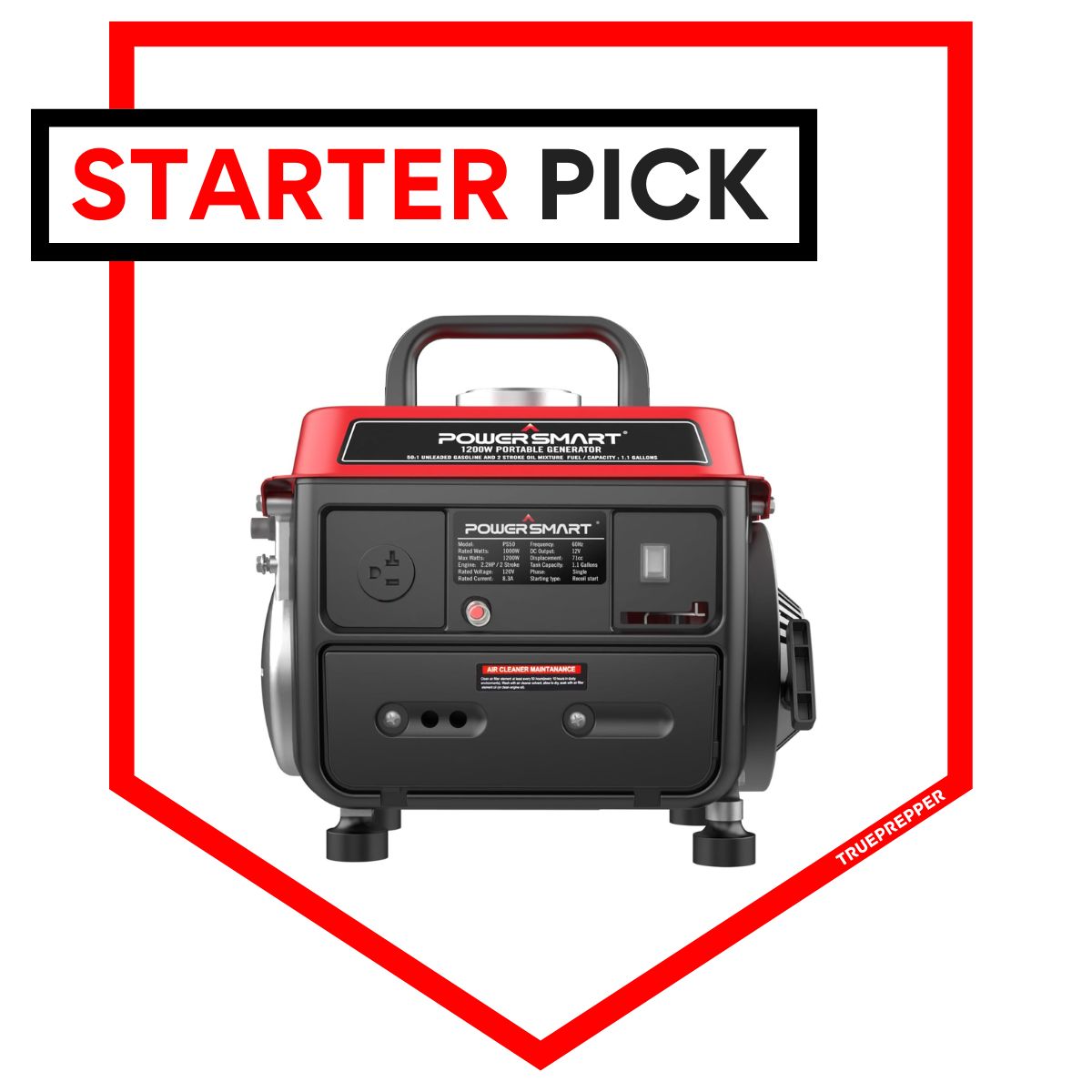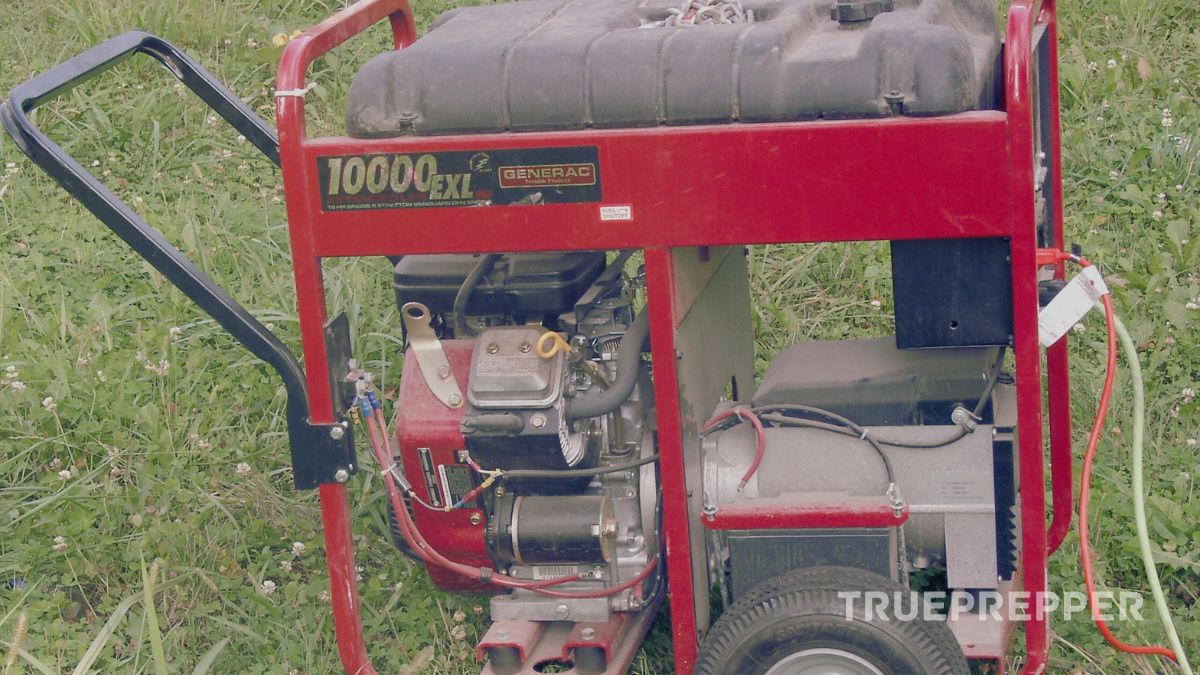Generators of all shapes and sizes are useful for preparedness, but portable generators bring the versatility preppers are looking for. They provide energy through regional disasters and emergencies but also have the versatility to be used for mobile prepping projects or bug out locations. There are many brands and types of portable gas generators to consider.
This is where we come in. We’ve researched the best portable generators, put them to the test, and now the results are in: the overall best, a budget option, and an upgrade option. If you need to keep electronics running in an emergency, one of our picks will pack some power.
Contents (Jump to a Section)
The Best Portable Generator
DuroStar DS4000S
High Wattage, Efficient, and Durable
Power your equipment anywhere with this smaller but powerful generator at a great value.
*Price at time of publishing; check for price changes or sales.
DuroStar makes a lot of models of portable generators but this one hits the sweet spot of power and runtime while still being manageable enough to move around. You can power plenty of appliances and lights through an outage, or take it to your bug out location to get some projects done. It’ll keep up with its massive 3,300 running watts.
Here is what you get with the DS4000S:
- 3,300 Watts running (4,000W peak)
- 2x 120V 20A outlets, 1x 120V 30A twist lock outlet
- 208cc engine w/ 4 gal gas tank (8-hour runtime)
- EPA and CARB-compliant
- 23″ L x 17″ W x 18″ H
- 94 Pounds
Why we like it:
- Enough running Watts to run virtually any appliance during a disaster, even central AC.
- The runtime is long enough for overnight emergency lighting.
- It’s small and light enough to move short distances or by vehicle. A wheel kit could help though.
With good reliability, high wattage, and a great price, it’s easy to see why the DuroStar DS4000S Generator is the best for prepping.

Budget Generator
PowerSmart Ultralight
Inexpensive, Small, and Powerful
This little guy packs a punch way over its cost and size with over 1,000 running watts on a small 71cc engine.
*Price at time of publishing; check for price changes or sales.
If you don’t have a generator or much room to store one, this could still fit the bill. It’s surprisingly affordable for 1,000 watts of power. The main drawback is that PowerSmart uses a 2-stroke engine to keep the weight and cost down, so you’ll need to mix some oil to make a 50:1 gas mix.
Here is how this cheap generator measures up:
- 1,000 Watts running (1,200W peak)
- 1x 120V 20A outlets, 1x 12V DC output
- 71cc engine w/ 1.1 gal gas tank (5-hour runtime)
- EPA and CARB-compliant
- 16″ L x 14″ W x 14″ H
- 37.8 Pounds
Why we like it:
- Powerful enough to run a fridge, but really this one is all about the budget price.
- The two-stroke engine can be a pain, but that can be overlooked for price and portability.
- This generator is tiny, lightweight, and it won’t be a budget-breaking investment.
If you are looking for an inexpensive option to do project work and light-duty projects, the PowerSmart Ultralight Generator is what you need.

Upgrade Dual Fuel Generator
Champion Dual Fuel
Versatile, Lightweight, and Quiet
Versatile fuel choices pair with smart controls to provide a small lightweight generator as the optimal portable solution.
*Price at time of publishing; check for price changes or sales.
Champion has really knocked it out of the park, and we think that this model hits the absolute sweet spot of versatility, value, and power. Not only can you fuel this with gasoline or propane, but you can link multiple together without any significant power loss.
This is because this is an inverter generator. While that’s not necessarily new technology, it is more expensive. The power provided is more consistent, has less harmonic distortion, and can power equipment using less fuel. It also allows for the linking we mentioned above.
Here are the full specs:
- 1,850 Watts running (2,500W peak)
- 2x 120V 20A outlets, 1x 12V DC output, USB adapter
- 79cc engine w/ 1.1 gal gas tank (11.5-hour runtime, 34-hour w/ LP 20lb tank)
- EPA and CARB-compliant
- 18″ L x 12″ W x 18″ H
- 39 Pounds
Why we like it:
- We could power multiple critical appliances with the running watts.
- This model can expand by daisy chaining several together.
- The lengthy runtime with multiple fuel types plus the CO2 shutoff gives peace of mind when running overnight.
If you are looking for the hands-down best portable generator, grab a Champion Dual Fuel 2500W Generator.
Everything We Recommend
The Generators We Compared
Our research narrowed the field down to several brands and types of generators that we compared: Honda, DeWalt, Craftsman, DuroStar, Generac, Champion, PowerSmart, Westinghouse, Pulsar, and more.
You can see our full list of review criteria below in the What to Look For section, with an explanation for each.
We considered a huge range of generator brands and types. We narrowed it down to portable generators in a specific wattage range, and then compared the efficiency, power, and durability in standard tests. We also limited our selection to generators that were practically portable in size and weight.
We’re always looking for new and better gear, so if you have a portable generator that you swear by, let us know in the comments. We review most of our tested equipment annually so we can try to get it in the next roundup round and see if it will beat out our top picks.
What to Look For
The best portable generators have a few features to look for:
- Value
- Power
- Versatility
- Size & Weight
- Durability
When you get the right blend of these, you can find a generator that will keep your gear reliably powered in survival situations. Below, we break down what each of these features means for the generators that truly set themselves apart.
Value: Cost vs. Benefit
The amount of money you spend on something like a generator shouldn’t blow out your entire budget. They come in a wide range of sizes, power levels, and cost so you should be able to find something specific to your needs on budget.
You never want to spend too much money on one thing when it comes to prepping equipment, especially if it’s one of several power sources. It’s better to diversify your gear and budget to make sure you are covered for a wide range of scenarios.
Power
A generator’s power is typically laid out as it’s running and peak wattage. Before you go looking for a generator, you should understand what type of power load you would like for it to handle and compare that to its listed running watts.
Many appliances and tools list their wattage needs on the Energy Star label or near the serial/model number. Be sure that the generators you are considering can perform up to your expectations based on your equipment needs.
Versatility
Versatility is a broad category for generators. Their runtime, fuel source, built-in outlets, and engine controls all contribute to a generator’s overall versatility. Runtimes are often a factor in how large the engine is and the fuel tank, but some can be extended by running the engine at a lower power load or using an inverter generator.
Fuel source versatility is big for survival and prepping applications since that gives you more options in fuel storage and overlaps with other tools, equipment, and vehicles that you may also be storing fuel for.
The outlets provided by a generator and the power type (DC plugs, for example) also add to a generator’s versatility making it more useful in a wider range of scenarios.
Even the size and weight of a portable generator could be factored into its mobile versatility.
Size & Weight
Portable generators are usually less than 100 pounds and small enough to fit in a vehicle. Some of the wheeled models can push this limit, but can also provide enough power to rival installed generators. If you calculate that to be your need, you can weigh the pros and cons of it being ‘less portable’, even though you can wheel it around to where you need it.
For our purposes, we limited our comparison to generators that are practically portable for a single person to move easily. If you are looking to power your entire home through a power outage, you can get it done with a larger portable generator.
Durability
One of the most frustrating things you can encounter in life is to try and use a piece of equipment during an emergency just to have it not work or completely fail on you. Some call it Murphy’s Law, but it is usually an extension of relying on cheap gear or equipment that you haven’t maintained or stayed familiar with.
Gas generators have engines and need a little love and maintenance sometimes. With the models we suggest (even the 2-cycle), if you keep the gas fresh and maintain the engines at regular intervals, and most importantly- test and use the generators at regular intervals, they will be reliable in an emergency. Don’t get a generator and shove it in the farthest corner of your shed or garage- keep it in regular use and maintain it appropriately so it won’t let you down when you most need it.

How to Use a Generator for Survival
Picking out a generator that suits your needs can be more difficult than using a generator.
Start the generator following the manufacturing instructions (you may need to prime or choke) and use the correct fuel. From there, you can directly plug in appliances, or use extension cords and surge strips. Be sure that your cord setup is not too long to limit the amperage supplied to your equipment.
Here is FJ simply showing how to start a Honda generator:
Here are some more useful tips to set up your generator for a disaster:
Test the generator every month or two
A generator is no good when you don’t test and maintain it. Check the gas and oil levels. Start it up and let it run for 5 minutes. On the Duromax, the battery charging light will go out when topped up. With a solar charger already connected, it took only 3 minutes of the engine running for the charging light to go out.
After the generator runs, and it has a fuel switch on it (like the Duromax), turn the fuel off and let it run it until the engine stops. That clears the gas out of the carburetor. Let it cool off and then keep it covered so the weather doesn’t destroy it.
This is one of the best generator tips that can apply to any gear, really. Get your stuff out and use it- even if it is just emergency use.
Keep it away from the house when running
There is a big sticker on both of my generators that says to not run it in or near the house. These things stink when they run! Avoid the awful fumes and stay safe by keeping it as far as possible from the house. That will also keep the noise down.
Use the right gas
Only use ethanol-free gas and add the blue “Stabil” brand gas treatment. This will make it so the gas left in the tank and fuel lines won’t break down and ruin the engine. The blue stabilizer is marine grade and simply works better. Label your 5-gallon gas can as “Ethanol Free + Blue Stabilizer” and use it in all your small engines.
Don’t use power strips on the house end of an extension cord
Power strips are a failure point if you connect something like an electric space heater to your generator. The generator has its own circuit breaker. If you need extra plugs, get an outdoor-rated power cord with multiple plugs on the end.
Hire an electrician if you want a whole-house solution
If you have a ton of money, plunk down thousands of dollars for a whole-house generator. Most hardware stores sell them and they turn on automatically, test themselves, and make life easy.
Otherwise, you can use a small generator like the Duromax, a 240-volt cable, and a special plug next to your power meter. That plug must be installed by an electrician. The biggest note is that you MUST turn off the main house breaker before using that special plug. Once you do that, your generator can run your house. Just make sure not many appliances are running.
One last bonus nugget to close out my generator tips: generators have a grounding lug that many people ignore. To protect both the generator and appliances connected to it, the lug should be wired to a ground. Buy an 8-foot ground rod and lug from a hardware store, drive it in the ground, and wire to it.
Who Needs a Portable Generator?
If you are in an apartment you might not necessarily need a portable generator due to your building restrictions, but almost everyone else can easily make use of one. Whether it’s for project work or emergencies- or even just a backup to your existing generator solution, portable generators have been an important consideration for preparedness.
We highly suggest portable generators for:
Many people opt to get them to prepare for specific emergencies that result in widespread power outages:
- Hurricanes
- Flooding
- Earthquakes
Power outages themselves are cause enough for most people to invest in a generator. With infrastructure investment lagging, most countries’ power grids are becoming more fragile.
How We Review Products: We research thoroughly before selecting the best products to review. We have vast prepping and survival experience and bring in outside experts when needed. Hours on end are spent testing gear in stressful conditions and using specialized testing gear to verify claims. We assign performance criteria and impartially rate each tested item. Learn more about how we test.
Sources and References
All of our experience and the testing we do to determine the best portable generator are useless without listing our research sources and references. We leaned on these for the book knowledge that we paired with our hands-on testing and practical survival experience:
Blanks, J. (1997). Optimal Design of an Enclosure for a Portable Generator. Virginia Tech Masters Thesis. (Source)
Centers for Disease Control and Prevention, USA. (2005). Carbon monoxide poisoning from hurricane-associated use of portable generators. Morbidity and Mortality Weekly Report. Volume 54. Issue 28. Pages 697-700. (Source)
Wang, L., et al. (2013). Study of the impact of operation distance of outdoor portable generators under different weather conditions. Indoor and Built Environment. Volume 23. Issue 8. (Source)
The Final Word
Power up your prepping with a reliable generator. They can come in handy for a wide range of prepper projects and, of course, make living a lot easier during disasters and emergencies.
Here are a few other guides and reviews our subscribers have found helpful:
We presented quite a lot of information, but as always: if you have any questions let us know and we would be happy to help. Our research and testing found the DuroStar DS4000S Generator to be the best option given its value, power, versatility, size/weight, and durability.
Keep exploring, stay prepared, and be safe.
You’ve Been Missing Out
Join the 2+ million preppers that rely on our prepping advice by subscribing to TruePrepper.
- Practical guides and tips
- Useful survival giveaways
- Free, forever
- < 0.4% of people unsubscribe

Read the full article here
